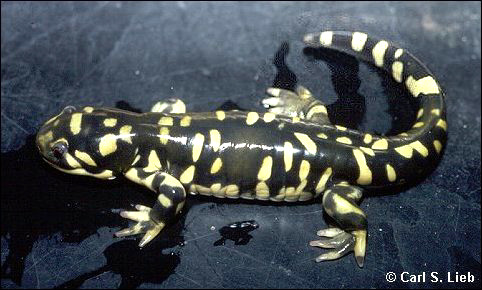
William Blake's famous poem, "The Tiger", starts off "Tiger, tiger, burning bright in the forests of the night..." Well we, in the Chihuahuan Desert, have our own tiger, also long associated with burning. No, not the great cat, but the Tiger Salamander. Old World mythology has it both that salamanders are deadly poisonous and that they will live happily amongst the blazing logs of a fire; in fact at one time asbestos was thought to be salamander wool!
Our salamander, like other local amphibians, starts out as a tadpole-like creature in a pool of water, eventually metamorphosing into the somewhat lizard-shaped, but scaleless, adult. Although indeed with the yellow and black colors of a tiger, the pattern is yellow splotches on a black background. More venturesome than frogs, adults may travel far from water in cool, moist weather, eventually sheltering in protected spots such as rodent burrows. If inadvertently exposed to our fiery sun, the myth of heat immunity is quickly disproved, as dehydration quickly turns our salamander into a very dead mummy.

Contributor: Arthur H. Harris, Laboratory for Environmental Biology, Centennial Museum, University of Texas at El Paso.
Desert Diary is a joint production of the Centennial Museum and KTEP National Public Radio at the University of Texas at El Paso.

Tiger Salamander. Photography by Carl S. Lieb.